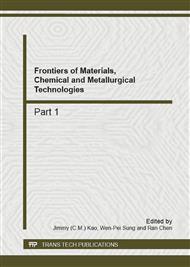[1]
Http: //www. Active-carbons.com/Info/Industrial News/77077.htm.
Google Scholar
[2]
Sun Kang, Jiang Jian-chun. Review on research progress and development trend of activated carbon at home and abroad. Chemistry and Industry of Forest Products, 2009.29(6):pp.98-104.
Google Scholar
[3]
Zhang Jun, Cen Xinguang, Xie Qiang, Wang Yanyan, Li Lanting. Decoloration of waste vegetable oil by activated carbon adsorption. Chinese Journal of Environmental Engineering, 2008.2(5): pp.716-720.
Google Scholar
[4]
Chang Mingquan,Chen Fang,Hao Xincai and Xiao Qin. Clinical Application of Detoxification with Activated Charcoal. Chinese Pharmaceutical Affairs, 2008.22(11): pp.1014-1015,1021.
Google Scholar
[5]
Liu Li-gen,Chen Jun,Xia Quan-qiu. Study on Activated Carbon Manufacture with Chinese Chestnut Skin. Hubei Agricultural Sciences, 2008.47(3): pp.337-339.
Google Scholar
[6]
Peng Jin hui, Zhang Shi ming, Zhang Li bo. Manufacture of Activated Carbon from Rice Stem by Microwave Radiation. Chemistry adn Industry of Forest Products, 1999.19(3): pp.88-90.
Google Scholar
[7]
Zhang Zhihang, Yu Shujuau, Li Guojt, Gao Dawei. Preparing Activated Carbon with Bagasse by Zinc Chloride Catalyzing. Sugarcane and Canesugar, 1998(4): pp.32-34.
Google Scholar
[8]
Han Bin et al. Studies on Adsorption Properties of Activated Carbon of Rice Straw on Phenol and Methylene Blue. Journal of Anhui Agricultural Sciences, 2009,37(7): pp.3196-3199.
Google Scholar
[9]
John Kennedyl,Vijayaj J,Kayalvizhi K,etal.Adsorption of phenolfrom aqueous solutions using mesoporous carbon prepared by two stage process[J]. Chemical Engineering Journal,2007,132(1/3): pp.279-287.
DOI: 10.1016/j.cej.2007.01.009
Google Scholar
[10]
Yan Lianhe,Wang Jianhong,Pan Aiqin,Zhou Shenfan,Chen Shouwen. Treatment of Methyl Orange Wastewater by Microwave Catalytic Oxidation Process. Environmental Protection of Chemical Industry, 2004,24(1): pp.38-41.
Google Scholar
[11]
Li Lian, Yuan Xingzhong, Liu Xianfeng, Zeng Guangming, Liu Jia, Tong Jingyi. Adsorption of Cd2+and Zn2+in Water by Bean Dregs. Environmental Protection of Chemical Industry, 2008,28(4): pp.296-299.
Google Scholar
[12]
Faria P C C,Crfao J J M, Pereira M F R, Adsorption of anionic and cationic dyes on activated carbons with different surface chemistries [J]. Water Res, 2004,38: pp.2043-2052.
DOI: 10.1016/j.watres.2004.01.034
Google Scholar
[13]
Lazar Idis N K, Karapantsios TD, Georgantasd. Kinetic analysis for the removal of a reactive dye from aqueous solution onto hydrotalcite by adsorption [J].Water Res,2003,37: pp.3023-3033.
DOI: 10.1016/s0043-1354(03)00121-0
Google Scholar
[14]
Wei Na , Zhao Nai-qin , Jia Wei , Wang Zhe-ren. Progresses in Preparation and Application of Activated Carbons. Carbon Techniques, 2003,126(3): pp.29-33.
Google Scholar
[15]
Yu Lan-lan Zhong Qin. The Research of Preparation of Actiovated Carbon Adsorbent Made from Sewage Sludge. Environmental Chemistry, 2005,24(4): pp.401-403.
Google Scholar
[16]
Zhang Bin, Pu Hongping. The Manufacture and Application Research of Sludge Absorbent With Carbon. Industrial Safety and Environmental Protection, 2006,32(2): pp.32-34.
Google Scholar
[17]
Hu Qiao-kai. A Study on the Removal of Acid Scarlet G from Water by Chitosan. Dyestuffs and Coloration, 2008,45(1): pp.53-55.
Google Scholar
[18]
Zhang Li-na,Chen Quan-yuan,KE Yu-juan. Investigation on Preparation and Decolorization for Dye Waste Water of Activated Carbon from Sludge. 2009, 16(1): pp.44-47.
Google Scholar
[19]
National Standards of Peoples Republic of China. Test methods of wooden activated carbon-Determination of methylene blue adsorption. GB/T12496. 10-1999, pp.262-264.
Google Scholar
[20]
Wang Hu-kun,Chen Shao-hua. Study on preparation and dyeing wastewater treatment of activated carbon from walnut hull. Textile Auxiliaries, 2008,25(8): pp.13-15.
Google Scholar


